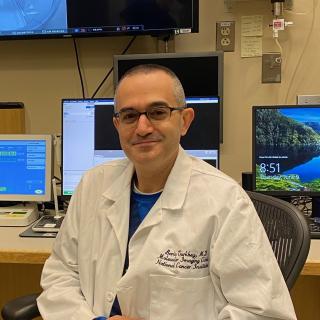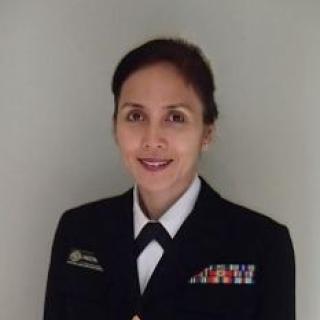Molecular Imaging Branch
Information for Patients
Learn more about our clinical trials and the highly specialized care teams that lead them.
Molecular Imaging Branch
About
The goal of the Molecular Imaging Branch (MIB) is to develop targeted imaging methods that accelerate the development of cancer therapies. The MIB is focused on the development and translation of in vivo molecular imaging agents for early detection, monitoring and therapy. Given the high risks and high costs of conducting research in this field, the MIB is well positioned to address the challenges that the field of molecular imaging faces.
Molecular Imaging Clinic
The Molecular Imaging Clinic conducts early phase trials of molecular imaging agents and is located in the NIH Clinical Center (Building 10) on the main NIH campus in Bethesda, MD. We investigate diagnostic imaging agents that employ nuclear, optical or magnetic resonance reporters in human subjects. Currently, there are six active human protocols. This effort is supported by a network of chemistry laboratories, including the Chemical Synthesis Center, the Cancer Imaging Program's Scientific Support Laboratory, and the PET Department of the NIH Clinical Center.
Pre-Clinical Imaging Laboratories
Laboratory of Radiopharmaceutical Development
Led by Orit Jacobson-Weiss, Ph.D., this laboratory’s current portfolio includes the development of PET and Theranostic agents for tumor and immune targets as well as methods to improve the therapeutic index by reducing on-target, off-tumor cytotoxicity.
Laboratory of Cellular Therapeutics
Led by Noriko Sato, M.D., Ph.D., this group aims to develop and use imaging techniques to uncover the fate of cells administered as cellular therapies and to better understand the mechanism of immune activation.
Laboratory of Theranostics
Led by Hisataka Kobayashi, M.D., Ph.D., this lab has developed activatable optical contrast agents. Additionally, Dr. Kobayashi's team has identified antibody-photosensitizer conjugates (APCs) that produce highly targeted necrotic cell death. This has been termed "photoimmunotherapy" and has entered clinical trials. They are also developing a variety of radionuclide-√targeted imaging agents for clinical translation.
Targeted Radionuclide Therapy Section
Led by Frank I. Lin, M.D., the Targeted Radionuclide Therapy (TRT) Section is dedicated to bringing promising TRT agents from the laboratory into patients on clinical trials, ranging from first-in-human phase 1 trials to collaborating on international multicenter phase 3 trials. This Section also has expertise in the pre-clinical development of promising future TRTs, with a special interest in small molecule agents and high LET radionuclides such as alpha or Auger-electron-emitting radioisotopes
Laboratory of Molecular Radiotherapy
Led by Freddy E. Escorcia, M.D., Ph.D., the Laboratory of Molecular Radiotherapy is focused on engineering tumor-selective molecular probes for human cancers, with particular interest in hepatobiliary malignancies. The lab combines bioinformatics, bioconjugate chemistry, radiochemistry, molecular biology and animal models to identify tumor-selective molecules then engineers and screens agents for subsequent use in cancer imaging and therapy. Current cross-institute efforts involve the targeting of hepatocellular carcinoma-selective markers for ultimate use in imaging-based screening of high-risk patient populations, detection of early recurrences, and therapy selection.
Comparative Oncology Program
Led by Amy LeBlanc, D.V.M., the Comparative Oncology Program (COP) uses naturally occurring cancers seen in pet animals to better understand the biology of cancer, with the goal of accelerating drug and imaging agent development for humans.
Artificial Intelligence Resource
Led by Baris Turkbey, M.D., the Artificial Intelligence Resource (AIR) makes AI tools available to Center for Cancer Research (CCR) investigators. The strength of AI is that algorithms can be trained to seek specific information that may be scientifically or clinically important. AIR will focus mainly on “Computer Vision” which analyzes medical images, such as radiologic, digital pathology, video/endoscopy and optical imaging, among others. Examples of potential projects include developing better screening, detection methods or predictive markers, or improving procedures among many others. Both clinical and laboratory-based imaging projects will be considered.
Clinical Trials
Job Vacancies
We have no open positions in our group at this time, please check back later.
To see all available positions at CCR, take a look at our Careers page. You can also subscribe to receive CCR's latest job and training opportunities in your inbox.
News
Learn more about CCR research advances, new discoveries and more
on our news section.
Resources
Artificial Intelligence Resource
Led by Baris Turkbey, the Artificial Intelligence Resource (AIR) makes AI tools available to Center for Cancer Research (CCR) investigators. The strength of AI is that algorithms can be trained to seek specific information that may be scientifically or clinically important. AIR will mainly focus on “Computer Vision” which analyzes medical images such as radiologic, digital pathology, video/endoscopy and optical imaging, among others. Examples of potential projects include developing better screening, detection methods or predictive markers, or improving procedures among many others. Both clinical and laboratory-based imaging projects will be considered. To learn more, visit https://ostr.ccr.cancer.gov/emerging-technologies/air/
Contact
Contact Info
Center for Cancer Research National Cancer Institute
- Building 10, Room B3B69
- Bethesda, MD 20892-1088
- 240-858-7355










